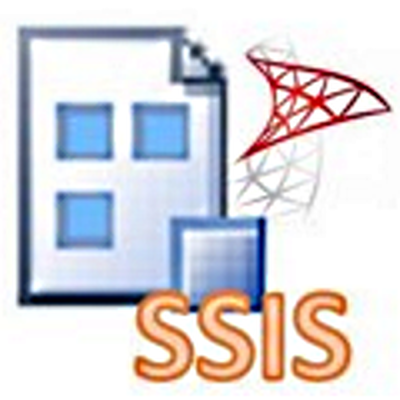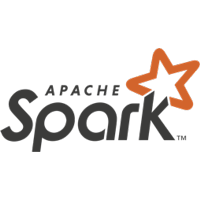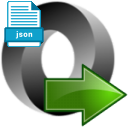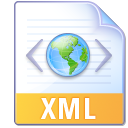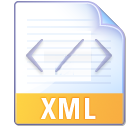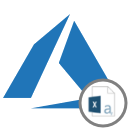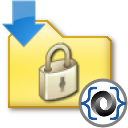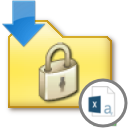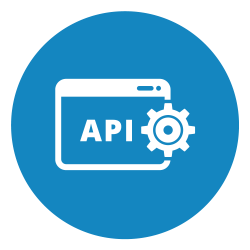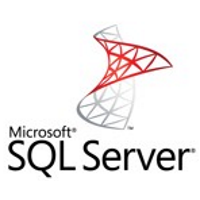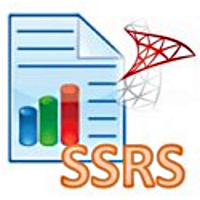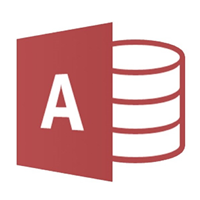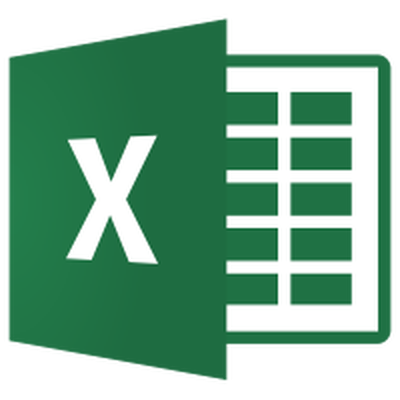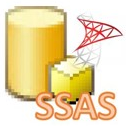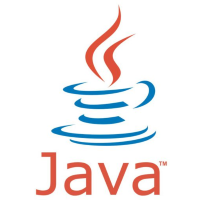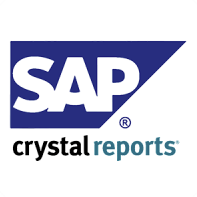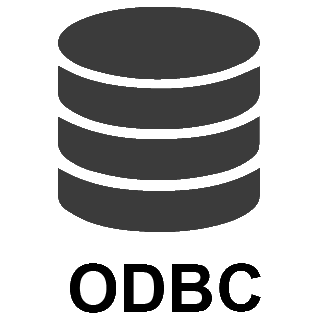Cosmos DB Connector for SSISConnect to your Azure Cosmos DB databases to read, query, create, update, and delete documents and more! In this article you will learn how to quickly and efficiently integrate Cosmos DB data in SSIS without coding. We will use high-performance Cosmos DB Connector to easily connect to Cosmos DB and then access the data inside SSIS. Let's follow the steps below to see how we can accomplish that! Cosmos DB Connector for SSIS is based on ZappySys API Connector Framework which is a part of SSIS PowerPack. It is a collection of high-performance SSIS connectors that enable you to integrate data with virtually any data provider supported by SSIS, including SQL Server. SSIS PowerPack supports various file formats, sources and destinations, including REST/SOAP API, SFTP/FTP, storage services, and plain files, to mention a few (if you are new to SSIS and SSIS PowerPack, find out more on how to use them). |
Connect to Cosmos DB in other apps
|
Video Tutorial - Integrate Cosmos DB data in SSIS
This video covers the following topics and more, so please watch carefully. After watching the video, follow the steps outlined in this article:
- How to download and install the required PowerPack for
Cosmos DB integration in SSIS - How to configure the connection for
Cosmos DB - Features of the
ZappySys API Source (Authentication / Query Language / Examples / Driver UI) - How to use the
Cosmos DB in SSIS
Prerequisites
Before we begin, make sure the following prerequisites are met:
- SSIS designer installed. Sometimes it is referred as BIDS or SSDT (download it from Microsoft).
- Basic knowledge of SSIS package development using Microsoft SQL Server Integration Services.
- SSIS PowerPack is installed (if you are new to SSIS PowerPack, then get started!).
Read data from Cosmos DB in SSIS (Export data)
In this section we will learn how to configure and use Cosmos DB Connector in API Source to extract data from Cosmos DB.
-
Begin with opening Visual Studio and Create a New Project.
Select Integration Service Project and in new project window set the appropriate name and location for project. And click OK.
-
In the new SSIS project screen you will find the following:
- SSIS ToolBox on left side bar
- Solution Explorer and Property Window on right bar
- Control flow, data flow, event Handlers, Package Explorer in tab windows
- Connection Manager Window in the bottom
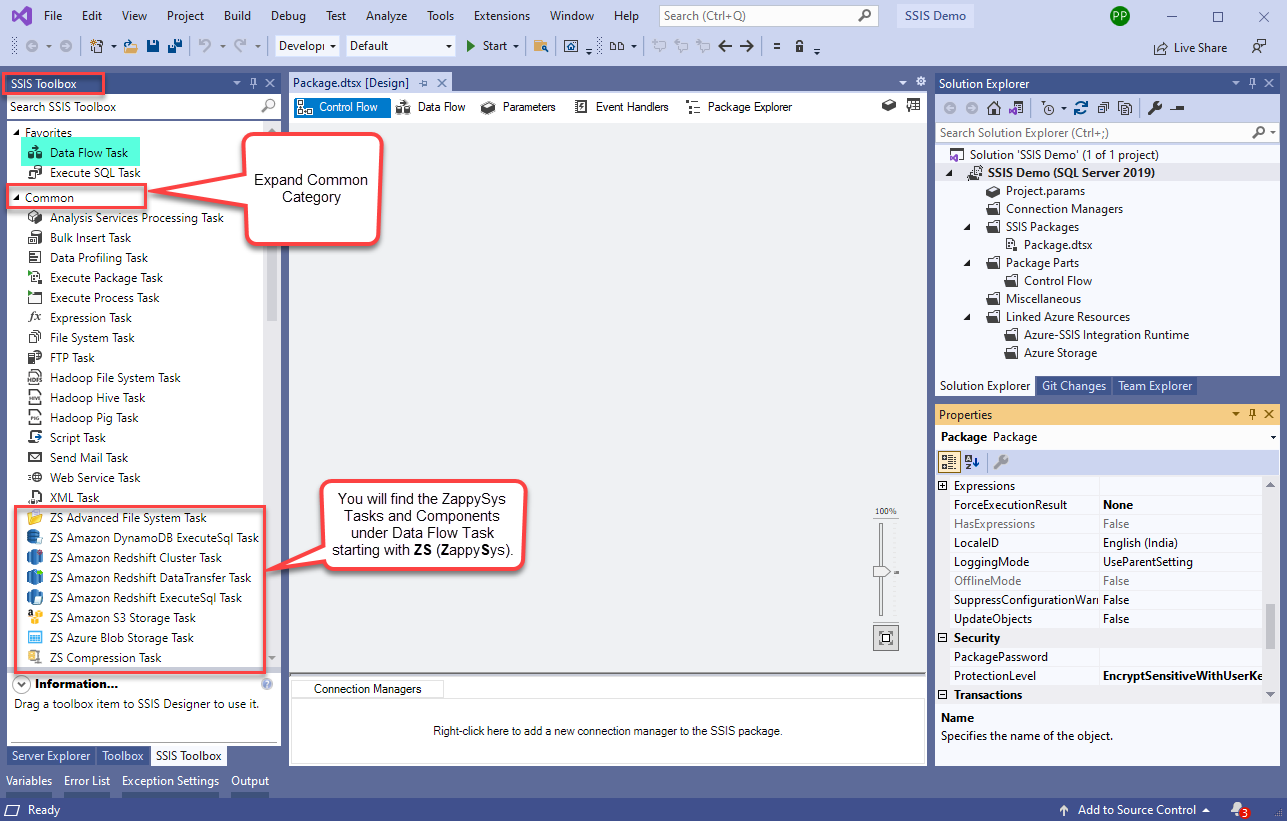 Note: If you don't see ZappySys SSIS PowerPack Task or Components in SSIS Toolbox, please refer to this help link.
Note: If you don't see ZappySys SSIS PowerPack Task or Components in SSIS Toolbox, please refer to this help link. -
Now, Drag and Drop SSIS Data Flow Task from SSIS Toolbox. Double click on the Data Flow Task to see Data Flow designer.
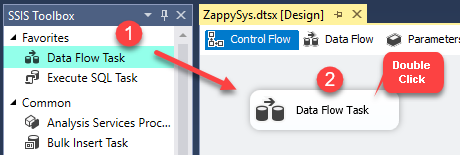
-
From the SSIS toolbox drag and API Source (Predefined Templates) on the data flow designer surface, and double click on it to edit it:
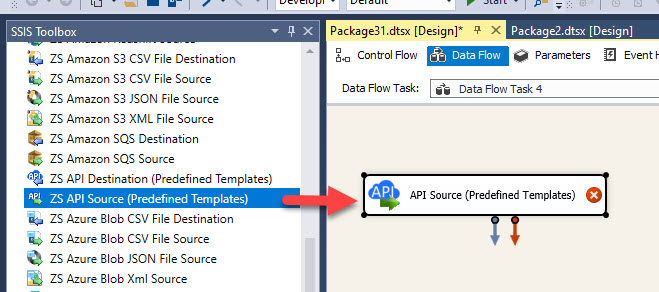
-
Select New Connection to create a new connection:
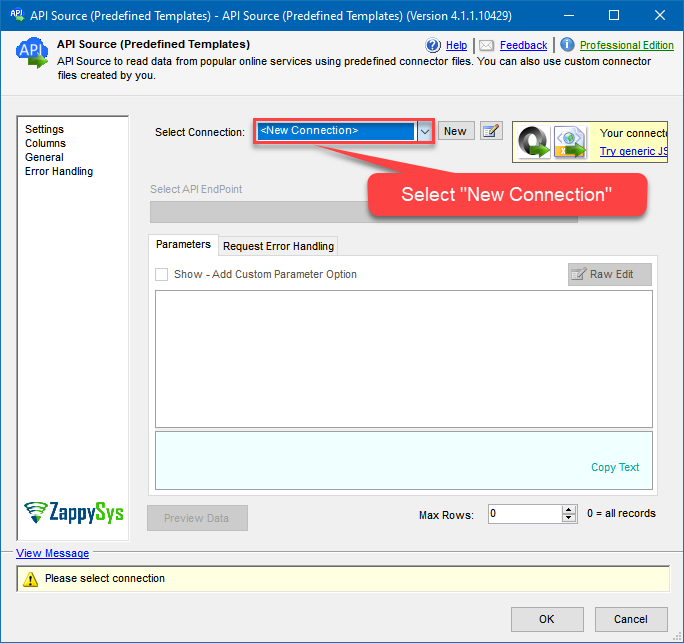
-
Use a preinstalled Cosmos DB Connector from Popular Connector List or press Search Online radio button to download Cosmos DB Connector. Once downloaded simply use it in the configuration:
Cosmos DB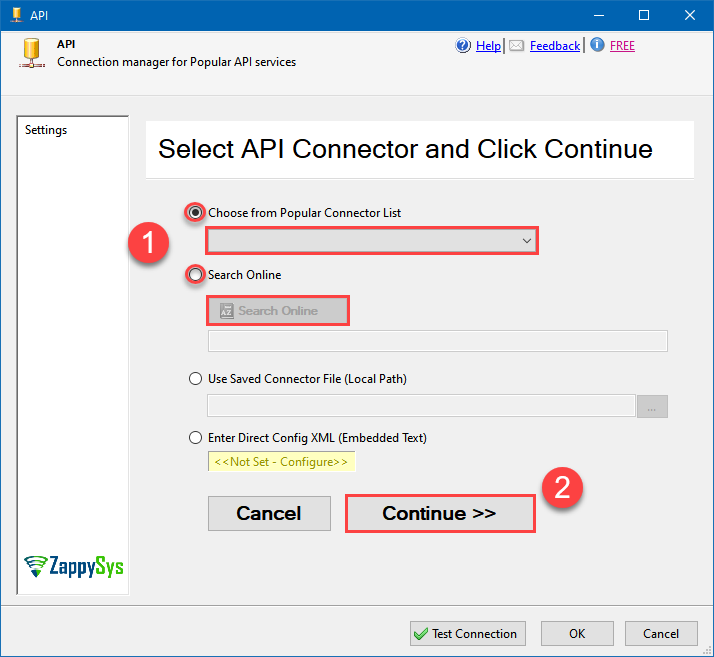
-
Proceed with selecting the desired Authentication Type. Then select API Base URL (in most cases default one is the right one). Finally, fill in all the required parameters and set optional parameters if needed. You may press a link Steps to Configure which will help set certain parameters. More info is available in Authentication section.
Steps how to get and use Cosmos DB credentials : API Key [Http]
Connecting to your Azure Cosmos DB data requires you to authenticate your REST API access. Follow the instructions below:- Go to your Azure portal homepage: https://portal.azure.com/.
- In the search bar at the top of the homepage, enter Azure Cosmos DB. In the dropdown that appears, select Azure Cosmos DB.
- Click on the name of the database account you want to connect to (also copy and paste the name of the database account for later use).
-
On the next page where you can see all of the database account information, look along the left side and select Keys:
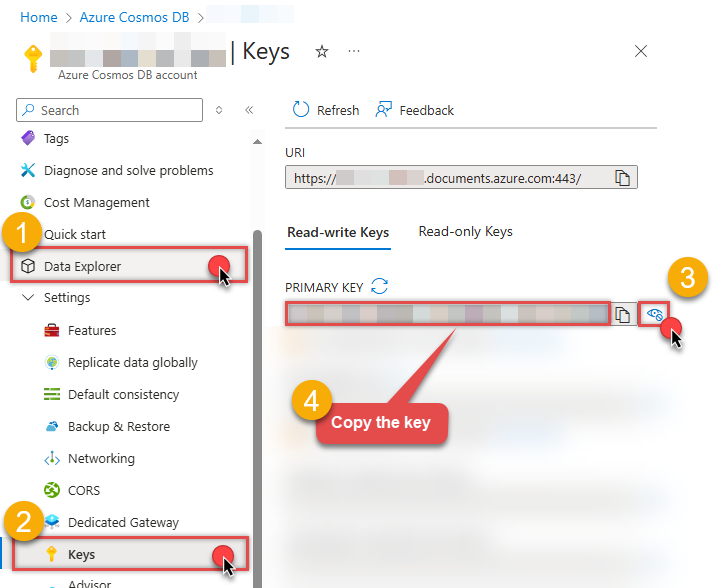
- On the Keys page, you will have two tabs: Read-write Keys and Read-only Keys. If you are going to write data to your database, you need to remain on the Read-write Keys tab. If you are only going to read data from your database, you should select the Read-only Keys tab.
- On the Keys page, copy the PRIMARY KEY value and paste it somewhere for later use (the SECONDARY KEY value may also be copied and used).
- Now go to SSIS package or ODBC data source and use this PRIMARY KEY in API Key authentication configuration.
- Enter the primary or secondary key you recorded in step 6 into the Primary or Secondary Key field.
- Then enter the database account you recorded in step 3 into the Database Account field.
- Next, enter or select the default database you want to connect to using the Defualt Database field.
- Continue by entering or selecting the default table (i.e. container/collection) you want to connect to using the Default Table (Container/Collection) field.
- Select the Test Connection button at the bottom of the window to verify proper connectivity with your Azure Devops account.
- If the connection test succeeds, select OK.
- Done! Now you are ready to use Asana Connector!
Configuring authentication parameters
Cosmos DBAPI Key [Http]https://[$Account$].documents.azure.comRequired Parameters Primary or Secondary Key Fill-in the parameter... Account Name (Case-Sensitive) Fill-in the parameter... Database Name (keep blank to use default) Case-Sensitive Fill-in the parameter... API Version Fill-in the parameter... Optional Parameters Default Table (needed to invoke #DirectSQL) 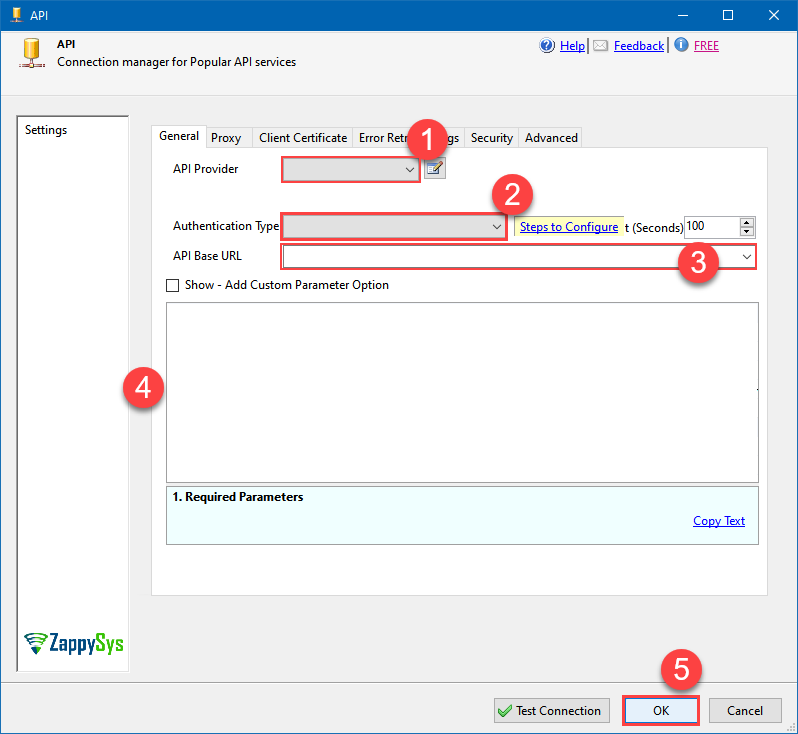
-
Select the desired endpoint, change/pass the properties values, and click on Preview Data button to make the API call.
API Source - Cosmos DBConnect to your Azure Cosmos DB databases to read, query, create, update, and delete documents and more!
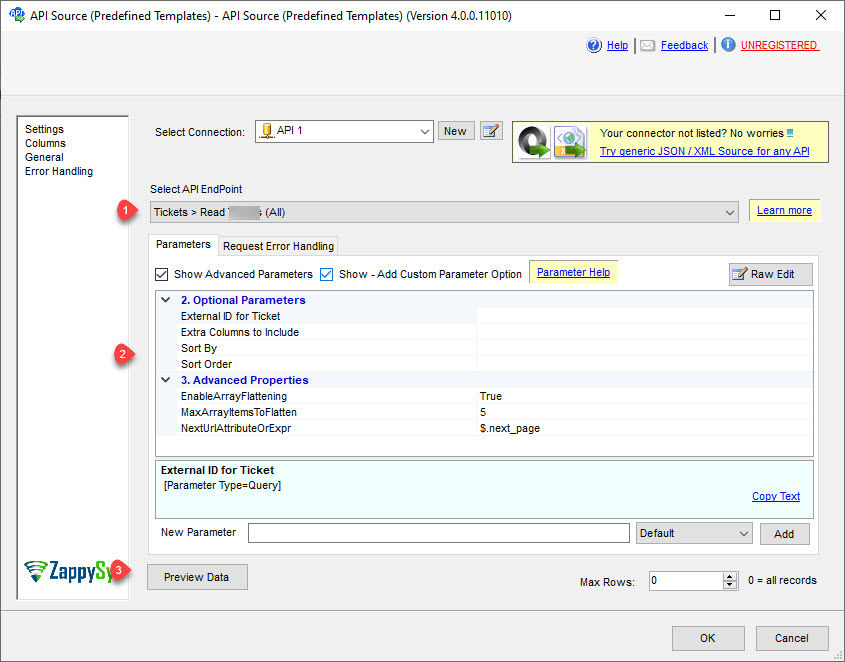
-
That's it! We are done! Just in a few clicks we configured the call to Cosmos DB using Cosmos DB Connector.
You can load the source data into your desired destination using the Upsert Destination, which supports SQL Server, PostgreSQL, and Amazon Redshift. We also offer other destinations such as CSV, Excel, Azure Table, Salesforce, and more. You can check out our SSIS PowerPack Tasks and components for more options. (*loaded in Trash Destination)
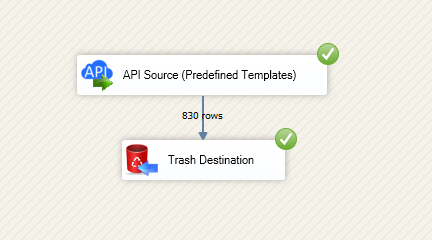
Write data to Cosmos DB using SSIS (Import data)
In this section we will learn how to configure and use Cosmos DB Connector in the API Destination to write data to Cosmos DB.
Video tutorial
This video covers following and more so watch carefully. After watching this video follow the steps described in this article.
- How to download SSIS PowerPack for
Cosmos DB integration in SSIS - How to configure connection for
Cosmos DB - How to write or lookup data to
Cosmos DB - Features about SSIS API Destination
- Using
Cosmos DB Connector in SSIS
Step-by-step instructions
In upper section we learned how to read data, now in this section we will learn how to configure Cosmos DB in the API Source to POST data to the Cosmos DB.
-
Read the data from the source, being any desired source component. In example we will use ZappySys Dummy Data Source component.
-
From the SSIS Toolbox drag and drop API Destination (Predefined Templates) on the Data Flow Designer surface and connect source component with it, and double click to edit it.
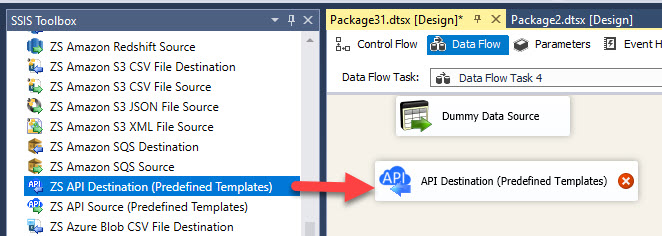
-
Select New Connection to create a new connection:
API Destination - Cosmos DBConnect to your Azure Cosmos DB databases to read, query, create, update, and delete documents and more!
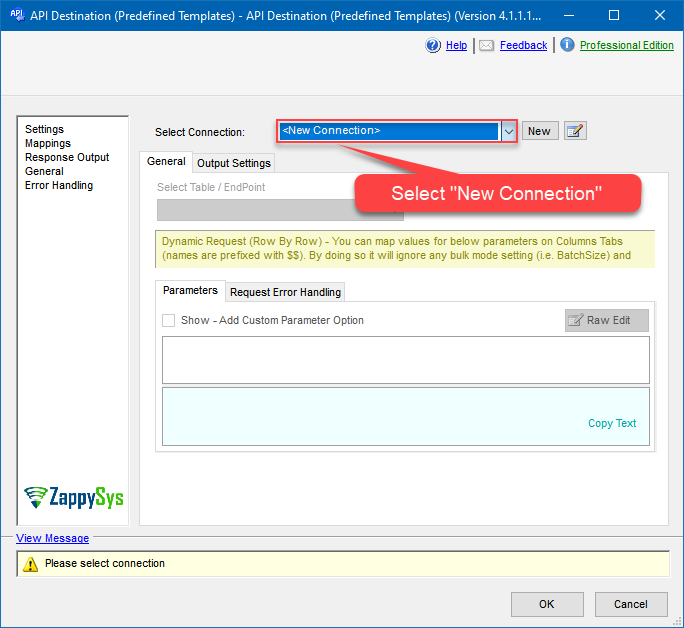
-
Use a preinstalled Cosmos DB Connector from Popular Connector List or press Search Online radio button to download Cosmos DB Connector. Once downloaded simply use it in the configuration:
Cosmos DB
-
Proceed with selecting the desired Authentication Type. Then select API Base URL (in most cases default one is the right one). Finally, fill in all the required parameters and set optional parameters if needed. You may press a link Steps to Configure which will help set certain parameters. More info is available in Authentication section.
Steps how to get and use Cosmos DB credentials : API Key [Http]
Connecting to your Azure Cosmos DB data requires you to authenticate your REST API access. Follow the instructions below:- Go to your Azure portal homepage: https://portal.azure.com/.
- In the search bar at the top of the homepage, enter Azure Cosmos DB. In the dropdown that appears, select Azure Cosmos DB.
- Click on the name of the database account you want to connect to (also copy and paste the name of the database account for later use).
-
On the next page where you can see all of the database account information, look along the left side and select Keys:

- On the Keys page, you will have two tabs: Read-write Keys and Read-only Keys. If you are going to write data to your database, you need to remain on the Read-write Keys tab. If you are only going to read data from your database, you should select the Read-only Keys tab.
- On the Keys page, copy the PRIMARY KEY value and paste it somewhere for later use (the SECONDARY KEY value may also be copied and used).
- Now go to SSIS package or ODBC data source and use this PRIMARY KEY in API Key authentication configuration.
- Enter the primary or secondary key you recorded in step 6 into the Primary or Secondary Key field.
- Then enter the database account you recorded in step 3 into the Database Account field.
- Next, enter or select the default database you want to connect to using the Defualt Database field.
- Continue by entering or selecting the default table (i.e. container/collection) you want to connect to using the Default Table (Container/Collection) field.
- Select the Test Connection button at the bottom of the window to verify proper connectivity with your Azure Devops account.
- If the connection test succeeds, select OK.
- Done! Now you are ready to use Asana Connector!
Configuring authentication parameters
Cosmos DBAPI Key [Http]https://[$Account$].documents.azure.comRequired Parameters Primary or Secondary Key Fill-in the parameter... Account Name (Case-Sensitive) Fill-in the parameter... Database Name (keep blank to use default) Case-Sensitive Fill-in the parameter... API Version Fill-in the parameter... Optional Parameters Default Table (needed to invoke #DirectSQL) 
-
Select the desired endpoint, change/pass the properties values, and go to the Mappings tab to map the columns.
API Destination - Cosmos DBConnect to your Azure Cosmos DB databases to read, query, create, update, and delete documents and more!
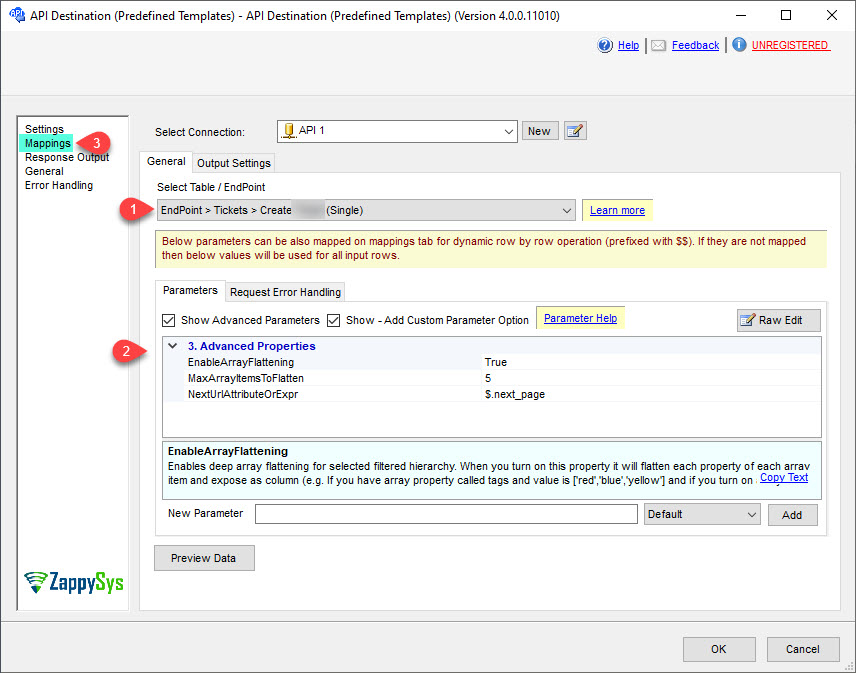
-
Finally, map the desired columns:
API Destination - Cosmos DBConnect to your Azure Cosmos DB databases to read, query, create, update, and delete documents and more!
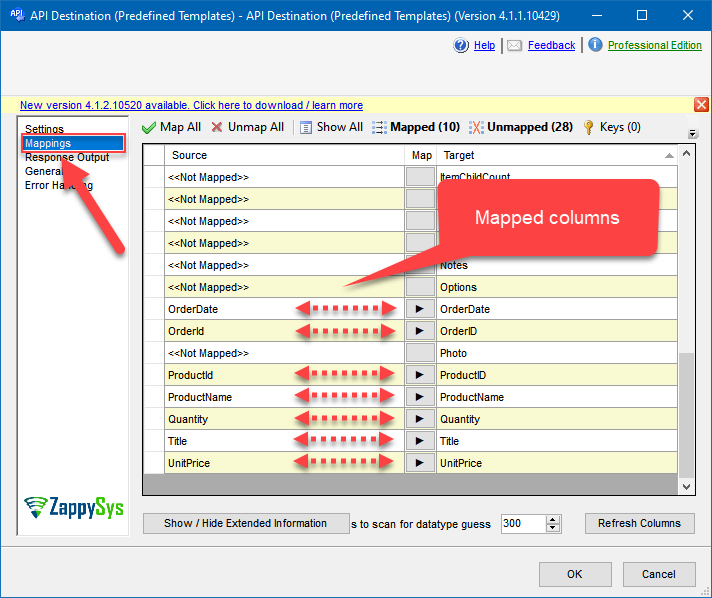
-
That's it; we successfully configured the POST API Call. In a few clicks we configured the Cosmos DB API call using ZappySys Cosmos DB Connector
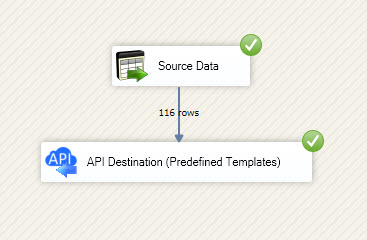
Load Cosmos DB data into SQL Server using Upsert Destination (Insert or Update)
Once you configured the data source, you can load Cosmos DB data into SQL Server using Upsert Destination.
Upsert Destination can merge or synchronize source data with the target table.
It supports Microsoft SQL Server, PostgreSQL, and Redshift databases as targets.
Upsert Destination also supports very fast bulk upsert operation along with bulk delete.
Upsert operation
- a database operation which performs INSERT or UPDATE SQL commands
based on record's existence condition in the target table.
It
Upsert Destination supports INSERT, UPDATE, and DELETE operations,
so it is similar to SQL Server's MERGE command, except it can be used directly in SSIS package.
-
From the SSIS Toolbox drag-and-drop Upsert Destination component onto the Data Flow designer background.
-
Connect your SSIS source component to Upsert Destination.
-
Double-click on Upsert Destination component to open configuration window.
-
Start by selecting the Action from the list.
-
Next, select the desired target connection or create one by clicking <New [provider] Connection> menu item from the Target Connection dropdown.
-
Then select a table from the Target Table list or click New button to create a new table based on the source columns.
-
Continue by checking Insert and Update options according to your scenario (e.g. if Update option is unchecked, no updates will be made).
-
Finally, click Map All button to map all columns and then select the Key columns to match the columns on:
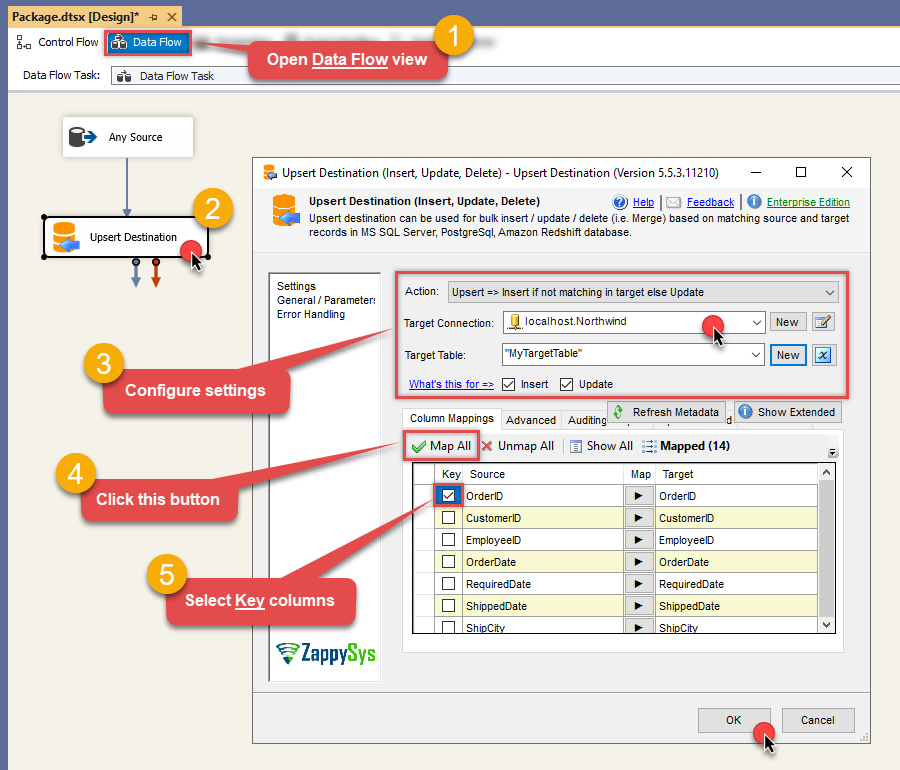
-
Click OK to save the configuration.
-
Run the package and Cosmos DB data will be merged with the target table in SQL Server, PostgreSQL, or Redshift:
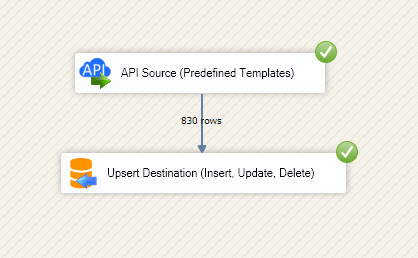
-
Done!
Deploy and schedule SSIS package
After you are done creating SSIS package, most likely, you want to deploy it to SQL Server Catalog and run it periodically. Just follow the instructions in this article:
Running SSIS package in Azure Data Factory (ADF)
To use SSIS PowerPack in ADF, you must first prepare Azure-SSIS Integration Runtime. Follow this link for detailed instructions:
Actions supported by Cosmos DB Connector
Cosmos DB Connector supports following actions for REST API integration:
Create a document in the container
Description
Insert JSON document in Cosmos DB Container.
Parameters
You can provide the following parameters to this action:
-
Table Name (Case-Sensitive) -
Database Name (keep blank to use default) Case-Sensitive -
Document -
Partition Key Value (default is supplied Id) -
Enable Upsert Mode (update if document found)
Input Fields
You can provide the following fields to this action:
-
PartitionKey -
Document
Output Fields
The following fields are returned after calling this action:
-
id -
_rid -
_ts -
http_status
Visit documentation for more information.
Create Permission Token for a User (One Table)
Description
Create a new user which you can later use to create permission set and obtain resource token.
Parameters
You can provide the following parameters to this action:
-
Permission Name (e.g. read_orders) -
User Name (Case-Sensitive) -
PermissionMode -
Table (Add Permission for this) -
Database Name (keep blank to use default) Case-Sensitive -
ExpiresInSecond
Input Fields
You can provide the following fields to this action:
-
N/A
Output Fields
The following fields are returned after calling this action:
-
Id -
PermissionMode -
Resource -
Token
Visit documentation for more information.
Create User for Database
Description
Create a new user which you can later use to create permission set and obtain resource token.
Parameters
You can provide the following parameters to this action:
-
Database Name (keep blank to use default) Case-Sensitive -
RequestBody
Input Fields
You can provide the following fields to this action:
-
N/A
Output Fields
The following fields are returned after calling this action:
-
Id -
ResourceId -
LastUpdated -
ETag -
Permissions
Visit documentation for more information.
Delete a Document by Id
Description
Deletes a Document by Id.
Parameters
You can provide the following parameters to this action:
-
Document Id -
Table Name (Case-Sensitive) -
Database Name (keep blank to use default) Case-Sensitive -
EnableCrossPartition -
Partition Key Value (default is supplied Id)
Input Fields
You can provide the following fields to this action:
-
Id
Output Fields
The following fields are returned after calling this action:
-
Id -
Status -
Table -
StatusCode
Visit documentation for more information.
Get All Documents for a Table
Description
Gets all documents for a Table.
Parameters
You can provide the following parameters to this action:
-
Table Name (Case-Sensitive) -
Database Name (keep blank to use default) Case-Sensitive -
Max Rows Per Page (Adjust for Speed)
Input Fields
You can provide the following fields to this action:
-
N/A
Output Fields
The following fields are returned after calling this action:
-
N/A
Visit documentation for more information.
Get All Users for a Database
Description
Gets all users for a Database.
Parameters
You can provide the following parameters to this action:
-
Database Name (keep blank to use default) Case-Sensitive -
Max Rows Per Page (Adjust for Speed)
Input Fields
You can provide the following fields to this action:
-
N/A
Output Fields
The following fields are returned after calling this action:
-
Id -
ResourceId -
LastUpdated -
ETag -
Permissions
Visit documentation for more information.
Get Database Information by Id or Name
Description
Gets a database by its Id.
Parameters
You can provide the following parameters to this action:
-
Database Name (keep blank to use default) Case-Sensitive
Input Fields
You can provide the following fields to this action:
-
N/A
Output Fields
The following fields are returned after calling this action:
-
Id -
ResourceId -
LastUpdated -
ETag -
Collections -
Users
Visit documentation for more information.
Get Document by Id
Description
Gets Document by Id.
Parameters
You can provide the following parameters to this action:
-
Document Id -
Table Name (Case-Sensitive) -
Database Name (keep blank to use default) Case-Sensitive -
EnableCrossPartition -
Partition Key Value (default is supplied Id) -
ConsistencyLevel
Input Fields
You can provide the following fields to this action:
-
N/A
Output Fields
The following fields are returned after calling this action:
-
N/A
Visit documentation for more information.
Get List of Databases
Description
Gets a list of the databases in the current database account.
Parameters
You can provide the following parameters to this action:
-
Max Rows Per Page (Adjust for Speed)
Input Fields
You can provide the following fields to this action:
-
N/A
Output Fields
The following fields are returned after calling this action:
-
Id -
ResourceId -
LastUpdated -
ETag -
Collections -
Users
Visit documentation for more information.
Get List of Tables
Description
Gets a list of the tables in the database. (Tables are also called 'containers' or 'collections').
Parameters
You can provide the following parameters to this action:
-
Database Name (keep blank to use default) Case-Sensitive -
Max Rows Per Page (Adjust for Speed)
Input Fields
You can provide the following fields to this action:
-
N/A
Output Fields
The following fields are returned after calling this action:
-
Id -
ResourceId -
LastUpdated -
ETag -
UniqueKeys -
IndexingPolicyIndexingMode -
IndexingPolicyAutomatic -
IndexingPolicyIncludedPaths -
IndexingPolicyExcludedPaths -
ConflictResolutionMode -
ConflictResolutionPath -
ConflictResolutionProcedure -
GeospatialConfigType -
PartitionKeyPaths -
PartitionKeyKind -
PartitionKeyVersion -
Documents -
StoredProcedures -
Triggers -
UserDefinedFunctions -
Conflicts
Visit documentation for more information.
Get table information by Id or Name
Description
Gets a table by its Id. (Tables are also called 'containers' or 'collections').
Parameters
You can provide the following parameters to this action:
-
Table Name (Case-Sensitive) -
Database Name (keep blank to use default) Case-Sensitive
Input Fields
You can provide the following fields to this action:
-
N/A
Output Fields
The following fields are returned after calling this action:
-
Id -
ResourceId -
LastUpdated -
ETag -
UniqueKeys -
IndexingPolicyIndexingMode -
IndexingPolicyAutomatic -
IndexingPolicyIncludedPaths -
IndexingPolicyExcludedPaths -
ConflictResolutionMode -
ConflictResolutionPath -
ConflictResolutionProcedure -
GeospatialConfigType -
PartitionKeyPaths -
PartitionKeyKind -
PartitionKeyVersion -
Documents -
StoredProcedures -
Triggers -
UserDefinedFunctions -
Conflicts
Visit documentation for more information.
Get table partition key ranges
Description
Gets Partition Key Ranges for a table. This is useful for query if you want to minimize scan to specific partition (Tables are also called 'containers' or 'collections').
Parameters
You can provide the following parameters to this action:
-
Table Name (Case-Sensitive) -
Database Name (keep blank to use default) Case-Sensitive
Input Fields
You can provide the following fields to this action:
-
N/A
Output Fields
The following fields are returned after calling this action:
-
N/A
Visit documentation for more information.
Get User by Id or Name
Description
Gets database user information for a specific Id.
Parameters
You can provide the following parameters to this action:
-
User Name (Case-Sensitive) -
Database Name (keep blank to use default) Case-Sensitive
Input Fields
You can provide the following fields to this action:
-
N/A
Output Fields
The following fields are returned after calling this action:
-
Id -
ResourceId -
LastUpdated -
ETag -
Permissions
Visit documentation for more information.
Query documents using Cosmos DB SQL query language
Description
Gets data based on the specified SQL query.
Parameters
You can provide the following parameters to this action:
-
Table Name (Case-Sensitive) -
SQL Query -
Database Name (keep blank to use default) Case-Sensitive -
Allow Query Scan -
Allow Cross Partition Query -
Cross Partition Key Range Id -
Max Rows Per Page (Adjust for Speed)
Input Fields
You can provide the following fields to this action:
-
N/A
Output Fields
The following fields are returned after calling this action:
-
N/A
Visit documentation for more information.
Update Document in the Container
Description
Update full or part of the document in Cosmos DB Container.
Parameters
You can provide the following parameters to this action:
-
Table Name (Case-Sensitive) -
Document Id -
Database Name (keep blank to use default) Case-Sensitive -
Document -
Partition Key Value (default is supplied Id)
Input Fields
You can provide the following fields to this action:
-
RequestMethod -
PartitionKey -
Id -
Document
Output Fields
The following fields are returned after calling this action:
-
id -
_rid -
_ts -
http_status
Visit documentation for more information.
Upsert a document in the container
Description
Insert JSON document in Cosmos DB Container.
Parameters
You can provide the following parameters to this action:
-
Table Name (Case-Sensitive) -
Upsert -
Database Name (keep blank to use default) Case-Sensitive -
Document -
Partition Key Value (default is supplied Id)
Input Fields
You can provide the following fields to this action:
-
PartitionKey -
Document
Output Fields
The following fields are returned after calling this action:
-
id -
_rid -
_ts -
http_status
Visit documentation for more information.
Make Generic API Request
Description
This is generic endpoint. Use this endpoint when some actions are not implemented by connector. Just enter partial URL (Required), Body, Method, Header etc. Most parameters are optional except URL.
Parameters
You can provide the following parameters to this action:
-
Url -
Body -
IsMultiPart -
Filter -
Headers
Input Fields
You can provide the following fields to this action:
-
N/A
Output Fields
The following fields are returned after calling this action:
-
N/A
Visit documentation for more information.
Make Generic API Request (Bulk Write)
Description
This is a generic endpoint for bulk write purpose. Use this endpoint when some actions are not implemented by connector. Just enter partial URL (Required), Body, Method, Header etc. Most parameters are optional except URL.
Parameters
You can provide the following parameters to this action:
-
Url -
IsMultiPart -
Filter -
Headers
Input Fields
You can provide the following fields to this action:
-
N/A
Output Fields
The following fields are returned after calling this action:
-
N/A
Visit documentation for more information.
Conclusion
In this article we showed you how to connect to Cosmos DB in SSIS and integrate data without any coding, saving you time and effort.
We encourage you to download Cosmos DB Connector for SSIS and see how easy it is to use it for yourself or your team.
If you have any questions, feel free to contact ZappySys support team. You can also open a live chat immediately by clicking on the chat icon below.
Download Cosmos DB Connector for SSIS Documentation

